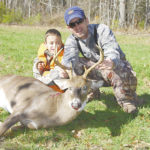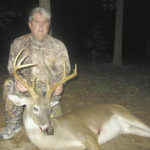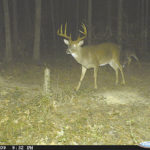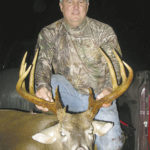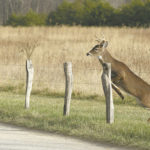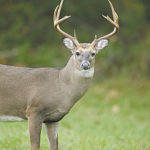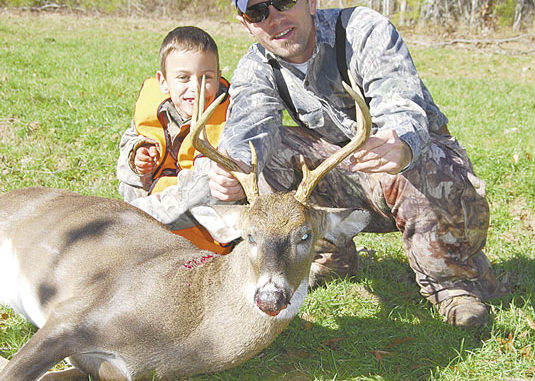
Throw on your warmest camo, and head to the woods with the next cold front. Deer change their behavior when it’s cold, and that puts the odds in your favor.
Ever see those pictures on the bags of food-plot seed of fields of ankle-deep greenery, all lush and verdant?
Well, this plot was the antithesis of that. It looked as though the land manager, for want of a tractor, prepped the seed bed with a steamroller. Sprigs of oats sprouted here and there through the concrete of earth in haphazard randomness.
If the ground had been a head and the vegetation had been hair, the barber had apparently been Edward Scissorhands.
The woods enclosing the 3-acre plot were nondescript. On two sides, 5-year-old pines grew to uniform heights, enshrouding the surface and squelching any undergrowth.
The other two sides were older pines, maybe late in their second decade of life, and they had clearly been thinned at some point.
If God had convened a committee of the most brilliant deer biologists in the world, and instructed them to name the perfect deer habitat, not a feature of this place would have been on the list.
Except, perhaps, for one: This boring chunk of woods with its pathetically laughable food plot was in the heart of Alabama’s Black Belt, a place where Nature has magically infused the soil with a pixie dust of nutrients that make the area’s plants loaded with vitamins and protein.
Literally five minutes after my son Joel and I arrived on the stand, a train of deer emerged from the short-pine thicket to the east, and set about their apparent quest to make the food plot look even worse.
For the next three hours, we were treated to a show more gripping and entertaining than anything the most brilliant Hollywood scriptwriter could ever dream up. Small rutting bucks harassed does like third-graders pulling pigtails, and bigger bucks charged from the woods to stake their rightful claims.
We were mesmerized.
You see, the place where Joel and I hunt regularly compares to the Alabama Black Belt about like a plastic Kmart kiddie pool compares to the Pacific Ocean.
We’re in the process of improving the property, as Sportsman contributor Chris Ginn has documented well in his annual Postage-Stamp Plots story, and we’ve seen impressive results, but we’re battling poor soil and inferior genetics in the piney woods of Washington Parish.
So we don’t measure the quality of hunts by using a clicker to keep track of the number of deer seen. Really, for us, even seeing a deer is a special treat.
Guys in the delta region of Louisiana and Mississippi and the aforementioned Black Belt of Alabama hardly even notice when a deer moves into a plot. They’ve become so jaded that nothing without a month’s supply of calcium on its head even raises their heart rate.
But we practically have to breathe into a bag to keep from hyperventilating if even a yearling moves within firing range.
Accordingly, we’re fanatics about hunting the weather. When conditions are perfect, our chances of seeing a deer are below average. When conditions are poor, well, we’d be better off staying home and watching Realtree videos.
Something we’ve noticed — amazing revelation here — is that deer move much more when it’s cold. If a stout front moves through overnight, the deer the next morning will be running around like Christmas shoppers at dawn the day after Thanksgiving.
It doesn’t matter if the wind’s blowing 30 m.p.h. out of the northwest — which it invariably is after a hard front — the deer will still move and be drawn to food sources during daylight hours.
But what is it about cold that makes deer move? I mean, it seems to me if I were a deer, and the temperature plummeted, I’d find a bed of pine needles or leaves, nestle in them, and let my thick back fur protect me from the bitter cold.
But apparently, if that were my tact, I’d be a deer popsicle by the end of my first winter.
Cold weather forces all warm-blooded animals to work harder to keep their bodies from becoming hypothermic. Like an engineer shoveling coal into the raging belly of his train’s engine, a deer must feed frequently in cold conditions to keep its body operating.
Even on warm days, deer will get up from their beds, stretch their legs and grab a snack several times before traveling to their feeding areas in the afternoon and evening hours, said Scott Durham, deer study leader for the Louisiana Department of Wildlife and Fisheries.
“Deer are designed to feed primarily in the early morning and evening, but … browse and feed intermittently during the day as well,” he said.
But on cold days, grabbing a snack just won’t cut it. Deer are often forced to move to substantial feeding areas during daylight hours, when they would normally be mostly out of sight.
That makes them vulnerable to hunters who have identified travel routes between bedding and feeding areas. Even old, wary, cautious, mature bucks that like being out in the open during daylight hours about as much as vampire bats do will move along their trails to stage at the edges of feeding areas just waiting for night to fall.
Less-cautious animals like does, fawns and young bucks won’t even wait for nightfall. Their rumbling stomachs and growing physiques overcome their caution, and feeding areas draw them no matter where the sun is in the sky.
Most of the time, these food resources are naturally occurring, but as fall turns to winter, native vegetation gets less nutritive for deer, Durham said.
“After a hard frost or two, some of the native vegetation becomes lower value as forage,” he said.
That’s when food plots begin to play a significant role, both in drawing deer out to within reach of hunters’ weapons and also to provide cold-weather forage for the herd.
“Big, lush, pH-balanced, fertilized green plots will serve to help sustain deer during cold months,” Durham said.
A deer can pick and pull on native browse in the thick forest, or it can put its head down and graze almost like a cow on nutrient-rich winter forage that’s fertilized and has the proper pH to deliver those nutrients to the plants.
In cold temperatures, the efficiency of the food plots wins almost every time.
Because of their ever-ready supply of highly palatable browse, food plots can also impact deer bedding locations on cold winter days.
Since the deer need to feed more frequently in cold weather, they often opt to bed down in closer proximity to food plots. This is important for hunters to keep in mind as they hike to their stand locations. Too much noise can alert deer in the area to the hunter’s presence, causing the deer to vacate one particular plot in favor of another.
Deer also tend to bed more in so-called “old-field” areas on really cold winter days to escape the chilly shade of the thick woods, Durham said.
“(The deer) will get some wind and thermal protection and insulation, but the sun can still shine on them and warm their bodies,” he said. “That’s why ‘old-field’ management has become popular.”
Even though deer are known to be nocturnal, particularly at this time of the year, severe cold will actually cause them to bed down during nighttime hours.
“When it gets really cold — teens to low 20s — deer stay bedded until it warms up some,” Durham said.
That means hunters can sleep in a little bit.
“If it is really cold, (deer) begin to move after the sun gets up over the trees and begins to melt off the frost,” Durham said. “In other words, on super-cold mornings, you might not need to be on your stand at the crack of dawn, unless you just want to get in there to enjoy the pre-dawn morning.”
And if that’s the case, you can always warm yourself up later with a nice bacon-wrapped backstrap.
